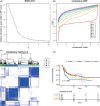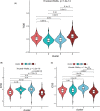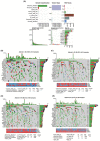Long noncoding RNAs to predict postoperative recurrence in bladder cancer and to develop a new molecular classification system
- PMID: 34816620
- PMCID: PMC8729057
- DOI: 10.1002/cam4.4443
Long noncoding RNAs to predict postoperative recurrence in bladder cancer and to develop a new molecular classification system
Abstract
Background: Reliable molecular markers are much needed for early prediction of recurrence in muscle-invasive bladder cancer (MIBC) patients. We aimed to build a long-noncoding RNA (lncRNA) signature to improve recurrence prediction and lncRNA-based molecular classification of MIBC.
Methods: LncRNAs of 320 MIBC patients from the Cancer Genome Atlas (TCGA) database were analyzed, and a nomogram was established. A molecular classification system was created, and immunotherapy and chemotherapy response predictions, immune score analysis, immune infiltration analysis, and mutational data analysis were conducted. Survival analysis validation was also performed.
Results: An eight-lncRNA signature classifed the patients into high- and low-risk subgroups, and these groups had significantly different (disease-free survival) DFS. The ability of the eight-lncRNA signature to make an accurate prognosis was tested using a validation dataset from our samples. The nomogram achieved a C-index of 0.719 (95% CI, 0.674-0.764). Time-dependent receiver operating characteristic curve (ROC) analysis indicated the superior prognostic accuracy of nomograms for DFS prediction (0.76, 95% CI, 0.697-0.807). Further, the four clusters (median DFS = 11.8, 15.3, 17.9, and 18.9 months, respectively) showed a high frequency of TTN (cluster 1), fibroblast growth factor receptor-3 (cluster 2), TP53 (cluster 3), and TP53 mutations (cluster 4), respectively. They were enriched with M2 macrophages (cluster 1), CD8+ T cells (cluster 2), M0 macrophages (cluster 3), and M0 macrophages (cluster 4), respectively. Clusters 2 and 3 demonstrated potential sensitivity to immunotherapy and insensitivity to chemotherapy, whereas cluster 4 showed potential insensitivity to immunotherapy and sensitivity to chemotherapy.
Conclusions: The eight-lncRNA signature risk model may be a reliable prognostic signature for MIBC, which provides new insights into prediction of recurrence of MIBC. The model may help clinical decision and eventually benefit patients.
Keywords: biomarker; bladder cancer; lncRNA; molecular subtypes; recurrence.
© 2021 The Authors. Cancer Medicine published by John Wiley & Sons Ltd.
Conflict of interest statement
The authors declare that they have no conflict of interest.
Figures






Similar articles
-
A robust signature of immune-related long non-coding RNA to predict the prognosis of bladder cancer.Cancer Med. 2021 Sep;10(18):6534-6545. doi: 10.1002/cam4.4167. Epub 2021 Aug 10. Cancer Med. 2021. PMID: 34374227 Free PMC article.
-
Six-long non-coding RNA signature predicts recurrence-free survival in hepatocellular carcinoma.World J Gastroenterol. 2019 Jan 14;25(2):220-232. doi: 10.3748/wjg.v25.i2.220. World J Gastroenterol. 2019. PMID: 30670911 Free PMC article.
-
Identification of an immune-related long non-coding RNA signature and nomogram as prognostic target for muscle-invasive bladder cancer.Aging (Albany NY). 2020 Jun 24;12(12):12051-12073. doi: 10.18632/aging.103369. Epub 2020 Jun 24. Aging (Albany NY). 2020. PMID: 32579540 Free PMC article.
-
Long non-coding RNAs as prognostic biomarkers in non-muscle invasive bladder cancer: A systematic review.Narra J. 2024 Dec;4(3):e1233. doi: 10.52225/narra.v4i3.1233. Epub 2024 Nov 1. Narra J. 2024. PMID: 39816119 Free PMC article.
-
Non coding RNAs as the critical factors in chemo resistance of bladder tumor cells.Diagn Pathol. 2020 Nov 12;15(1):136. doi: 10.1186/s13000-020-01054-3. Diagn Pathol. 2020. PMID: 33183321 Free PMC article. Review.
Cited by
-
Deciphering riddles in molecular subtyping of bladder cancer.Asian J Urol. 2025 Apr;12(2):217-231. doi: 10.1016/j.ajur.2024.09.006. Epub 2024 Dec 5. Asian J Urol. 2025. PMID: 40458574 Free PMC article. Review.
References
-
- Antoni S, Ferlay J, Soerjomataram I, Znaor A, Jemal A, Bray F. Bladder cancer incidence and mortality: a global overview and recent trends. Eur Urol. 2017;71(1):96‐108. - PubMed
-
- Stein JP, Lieskovsky G, Cote R, et al. Radical cystectomy in the treatment of invasive bladder cancer: long‐term results in 1,054 patients. J Clin Oncol. 2001;19(3):666‐675. - PubMed
-
- Alfred Witjes J, Lebret T, Compérat EM, et al. Updated 2016 EAU Guidelines on muscle‐invasive and metastatic bladder cancer. Eur Urol. 2017;71(3):462‐475. - PubMed
-
- Sternberg CN, Skoneczna I, Kerst JM, et al. Immediate versus deferred chemotherapy after radical cystectomy in patients with pT3‐pT4 or N+ M0 urothelial carcinoma of the bladder (EORTC 30994): an intergroup, open label, randomised phase 3 trial. Lancet Oncol. 2015;16(1):76‐86. - PubMed
Publication types
MeSH terms
Substances
LinkOut - more resources
Full Text Sources
Medical
Research Materials
Miscellaneous

